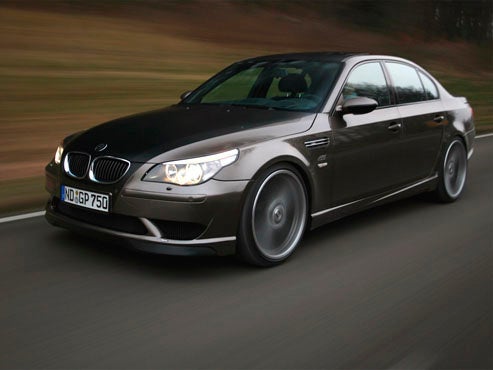The M5 is, and always has been, the distillation of everything that makes BMW cars special. M division engineers, endowed with a streak of lunacy, take an already great BMW 5-series car and add power, improve its handling, and create a sedan that takes on dedicated sports cars. You get the feeling these guys share a kinship with those fun-loving, society-be-damned types who put a few special ingredients into a still and create moonshine. In this case, it's the new, 500-hp BMW M5, the moonshine of cars.
The differences between a regular-production 5-series BMW and the no-holds-barred 2006 M5 have never been greater. First and foremost is the new engine. In today's automotive world of economies of scale, mergers, and collaborations, it is rare for an automaker to design an engine that is entirely new, but the 90-degree, 5.0-liter V-10 is an engine that must have skipped kindergarten because it doesn't share any of its parts. The high-revving V-10 was made for the M5 exclusively, and it makes the car feel as special as anything built outside of Maranello.
Compared2006 High-Performance Sedan ComparisonPress the button marked "power" next to the shifter, and you get 500 horsepower at 7750 rpm and 384 pound-feet of torque at 6100 rpm. That's 106 more horsepower than the previous M5's V-8 and 175 more than a 545i's. Don't press the button, and the intake restricts itself to 400 horses. On paper the rpm at which maximum torque is achieved seems a bit high, but variable valve timing and individual throttles for each cylinder allow the engine to enjoy low-end grunt and midrange power. There's almost always enough power on tap to induce midcorner oversteer at the briefest stab of the throttle. The V-10 sounds great, too. Tear away from a city stoplight and run the V-10 to its 8250-rpm redline, and you'll leave nascent car enthusiasts in your wake.
Aside from the new engine there is a new transmission—the third generation of BMW's sequential manual gearbox (SMG)—that takes lessons learned from Formula 1 and applies them to the M5. BMW does not offer a conventional manual transmission, and that seems counter to its Ultimate Driving Machine marketing mantra. Although this latest SMG is faster and smoother than ever, a skilled driver could achieve less jerky shifts. You may wonder why there's no conventional manual. It has to do with the way the gears are arranged in the tranny casing. First and second gears, which experience the most abuse and stress, find themselves nestled in the strongest parts of the casing to withstand the violently quick shifts that the SMG can make. The rest of the seven gears are arranged to follow the same logic. If the M5 had a normal shifter, its pattern would be a maze so intricate that even the smartest rats lured by the best cheese would have trouble figuring it out.
Since the shifts are governed by electronics, there are different settings that alter shift speed and clutch slip. There's also a fully automatic mode. On the other side of the spectrum is the entertaining launch-control function that allows for maximum acceleration with minimal effort. To trigger launch control, shut off stability control, set the gearbox for the fastest shifts, push the shifter forward, and floor the throttle. What's odd is that you don't need to hold down the brake pedal. When the engine revs rise to 4000 rpm, release the shifter and keep the accelerator pedal floored. Gearchanges are head-bangingly fast and at the perfect rpm, as the program knows exactly when to shift. If there's enough space, the M5 will run to an indicated 168 mph, although BMW claims the governor only allows for 155 mph, still safely within the limits of the Y-rated Continental SportContact 2 tires.
The BestBest Road Cars Ever Developed by BMW’s M DivisionIt is interesting to note what technology the M engineers had to scrap in order to make the M5 chassis perform. They ditched current 5-series innovations such as active steering, active anti-roll bars, and run-flat tires. In place of the active steering is a passive, mechanically variable ratio that changes imperceptibly once you turn the wheel past a certain point. There are two levels of power-steering assist, light and heavy, that change depending on which damper setting you choose (comfort, normal, or sport). In the softest setting, the dampers take the harshness out of the ride, and the steering is noticeably lighter in that mode.
There is so much adjustability to the new M5 that there's a button for programming the driver's preferences into a single setting. Press the M button on the steering wheel, and you get your favorite damper, steering, shift, power, and stability settings.
Braking gets an upgrade to keep the M5 in check. Big 14.7-inch rotors in front and 14.6-inchers in back slow the M5 from top speed quickly and without drama. Two-piston calipers clamp the front rotors. The M guys eschewed the fashionable four-, six-, and even eight-piston calipers because, they correctly claim, the effectiveness of the brakes is limited by tire traction, not rotor clamping force.
Leather covers nearly every part of the M5's lavish interior, and as with the last generation, buyers will have to choose between luxury (wood and more leather) and sport, which features aluminum accents in place of wood. Both cabins are a huge improvement over the regular 5-series interior and make you feel as if you were in a four-door Ferrari.
The M5 required so many platform changes that you can imagine the engineers letting out a collective groan when the latest 5-series appeared at their door for treatment. However, they were given the freedom and money to make their kind of car. What the M5 will cost the public has not yet been set, as this car is still a year away from our shores, but expect the price to start at about $90,000. That's expensive, but the next-cheapest four-seater that provides the M5's dynamic thrills is Ferrari's 612 Scaglietti, and it goes for $260,000. Like moonshine, the M5 provides the same kick for far less money.
SpecificationsSpecifications
2006 BMW M5
VEHICLE TYPE
front-engine, rear-wheel-drive, 5-passenger, 4-door sedan
BASE PRICE (EST)
$90,000
ENGINE TYPE
DOHC 40-valve 5.0-liter V-10, 500 hp, 383 lb-ft
TRANSMISSION
7-speed manual with automated shifting and clutch
DIMENSIONS
Wheelbase: 113.7 in
Length: 191.1 in
Width: 72.7 in
Height: 57.8 in
Curb weight (C/D est): 4050 lb
PERFORMANCE (MFR'S EST)
60 mph: 4.7 sec
Top speed: 155 mph
EPA FUEL ECONOMY (MFR'S EST)
European urban cycle: 10 mpg
Extra-urban cycle: 23 mpg
Combined: 16 mpg

115 Bmw M15 Photos Informations Articles BestCarMag
BMW M115 11515 215157 Auto images and Specification

115 BMW M15 159150 at Beverly Hills Auto Group

115 BMW M15 159150 at Beverly Hills Auto Group

115 Bmw M15 15 BestCarMag

115 Bmw M15 Photos Informations Articles BestCarMag

115 BMW M15 Touring Specs amp Fuel Economy Carsmind
115 BMW M15 Base 15dr Rearwheel Drive Sedan Pricing and Options

E15 Page 15 German Cars For Sale Blog
Bobver 115 BMW M15Sedan 15D Specs Photos Modification Info at

Sumptuous Bmw M15 15 Fastest Car Otopan

115 BMW M15 Touring Specs amp Fuel Economy Carsmind

115 BMW M15 CarGurus
Verticalmove 115 BMW M15Sedan 15D Specs Photos Modification Info

1115 BMW 115 Series 115drsdnm115rwd Specs JD Power